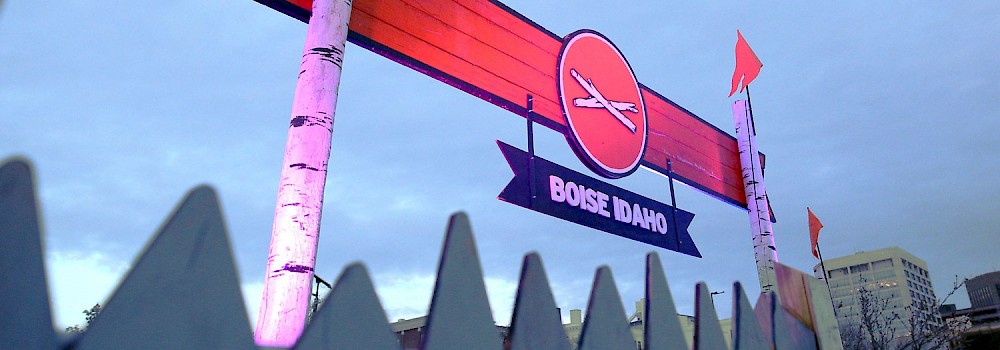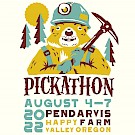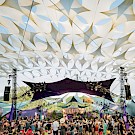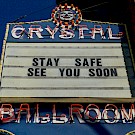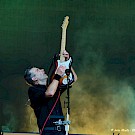 Rocking at El Korah: Photo by Christina BirkinbineIn its literature, Treefort Music Fest describes its bands as “emerging,” which seems an apt term for the high-risk, high-reward shows the 450-odd bands play.
Rocking at El Korah: Photo by Christina BirkinbineIn its literature, Treefort Music Fest describes its bands as “emerging,” which seems an apt term for the high-risk, high-reward shows the 450-odd bands play.
But the Boise festival itself, which just completed its fifth run, is hardly so described; in fact, it’s arguably already a Northwest institution.
There were plenty of shimmering moments: A blistering, humid set by San Francisco garage rockers Thee Oh Sees at El Korah Lounge; Washington, D.C. rapper Oddisee’s virtuosic set at the Knitting Factory; lovely disco-inflected electro from Vancouver, B.C.’s Bear Mountain at Rose Room; ferociously sensual, tongue-in-cheek rawk from Seattle anti-sweethearts Thunderpussy at Humpin’ Hannah’s; and several more.
And somehow, behind, underneath, connecting it all was the place itself, brisk in late March, cold after sundown, but charming, welcoming even.
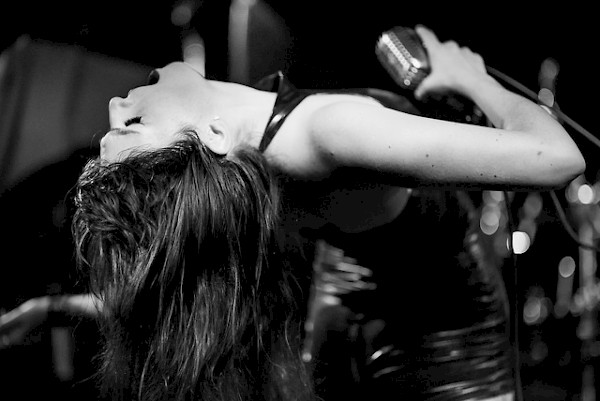 Thunderpussy's Molly Sides at Boise's Humpin' Hannah's: Photo by Maggie Mattinson“Idaho. Oooo,” Thunderpussy lead singer Molly Sides teased, looking at the audience, you know, just so—like she had a sexy secret she was just dying to tell. Perched behind two enormous American flags at Humpin’ Hannah’s, the Seattle quartet’s edgy, sensual set of ’70s pop meets punk and voluminous hair flips suggested the group is as likely as any other act at Treefort to actually, uh, emerge.
Thunderpussy's Molly Sides at Boise's Humpin' Hannah's: Photo by Maggie Mattinson“Idaho. Oooo,” Thunderpussy lead singer Molly Sides teased, looking at the audience, you know, just so—like she had a sexy secret she was just dying to tell. Perched behind two enormous American flags at Humpin’ Hannah’s, the Seattle quartet’s edgy, sensual set of ’70s pop meets punk and voluminous hair flips suggested the group is as likely as any other act at Treefort to actually, uh, emerge.
Drummer Lena Simon showed a technical virtuosity to rival any stick-holder at the fest, though the group’s songs sometimes seemed to reach a near-cathartic intensity level only to not really go anywhere.
But hey, punk was never about taking it to the bridge, right?
Thunderpussy was by no means the only inspiring female-dominated act at Treefort.
“I just want to thank Andrew, the drummer, for putting up with four girls, sisters no less, on this tour,” Australian band Stonefield’s mesmerizing lead singer Amy Findlay said with a giggle during the quintet’s classic rock set on the main stage. The group’s organ-heavy, Zeppelin-esque sound was pleasing, if not as sophisticated as the Page-Plant odysseys, and the growing main stage crowd looked intrigued but also a tad miserable in beanies and hoodies, probably because the mountain air was quickly moving from chilly to biting.
Not that there was any shortage of testosterone in evidence.
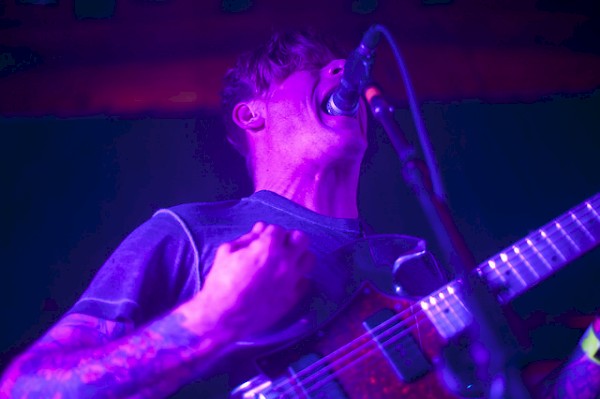 Thee Oh Sees' John Dwyer at El Korah Lounge: Photo by Patrick Sweeney“One last song,” Thee Oh Sees’ John Dwyer said to the sweaty, capacity crowd at El Korah Lounge near the end of a barn-burning set. “Long and thick ... and only for the boys, sorry ladies.”
Thee Oh Sees' John Dwyer at El Korah Lounge: Photo by Patrick Sweeney“One last song,” Thee Oh Sees’ John Dwyer said to the sweaty, capacity crowd at El Korah Lounge near the end of a barn-burning set. “Long and thick ... and only for the boys, sorry ladies.”
Thee Oh Sees’ set tipped the hat to Boise’s storied hardcore and punk scene, and if the drumming was as intense as Simon’s, it was because there were two drummers. It was only 39 degrees outside and past midnight, but band members wore shorts and sandals, and the several hundred attendees packing the El Korah created a humid heat wave.
Few bands can go from lush, melodic lulls to rip-your-face-off choruses as well as Thee Oh Sees, with percussionists Ryan Moutinho and Dan Rincon flowing together across airtight transitions like a funky supercomputer and Lee Scratch Perry-esque, haunting (if indecipherable) vocals from Dwyer. No Treefort audience witnessed by this writer was more riveted than this band’s.
At times, the fest’s “emerging” sets juxtaposed amazing with surreal.
Willis Earl Beal’s Boise Contemporary Theater show came across as so strange, so awkward that it almost seemed to defy or preempt any criticism.
“It’s just a performance, relax,” he said. “This is a place of masturbation.”
“Now I can’t find the fucking iPod,” Beal said during the soundcheck, not seeming to notice that the audience included children, or indeed, that there was an audience of at least 150. “I don’t want you to clap,” he continued, striding around the stage and testing his powerful, gospel-tinged vocals on the system along with his mp3 player (no band). “I like to keep it as awkward as possible. I like to feel like I’m alone.”
Many karaoke lounges might feel similar, if not quite on the same scale.
Waving a large maroon cape that perfectly matched his shirt, hat and pants, invoking Captain Beefheart, and turning delay and reverb up to underwater proportions, Beal sang with great power, but off-key. Meanwhile, backing tracks sounded like they were recorded on a shitty four-track with a cheap Yamaha synthesizer, bass and drums.
“These are really boring songs,” Beal said, inviting the audience to sleep. The strangeness of the schtick, the moment, reached the point that it seemed perhaps it was all an avant-garde parody. Unfortunately, it wasn’t.
 El Korah Lounge: Photo by Patrick SweeneyWhat is authenticity at a music festival? Well, there was no Doritos Stage. In fact, the entire festival appeared to have practically no branding, unless you include Treefort itself. Instead of corporate banners or reps, there was the wristband given by the shriners at El Korah Shrine, which read in all caps, “DRINK LIKE A FISH.”
El Korah Lounge: Photo by Patrick SweeneyWhat is authenticity at a music festival? Well, there was no Doritos Stage. In fact, the entire festival appeared to have practically no branding, unless you include Treefort itself. Instead of corporate banners or reps, there was the wristband given by the shriners at El Korah Shrine, which read in all caps, “DRINK LIKE A FISH.”
Authenticity is also when you don’t enjoy an act, but can respect that it’s not faking a single fucking thing. Clarke and the Himselfs, for example, brought a bunch of carnivalesque, whiskey-fueled power dirges to the Neurolux. The “deconstructionist” set by the Boise six-piece, led by Clarke Howell, was strangely hypnotic, except that the overuse of a cymbal on top of densely woven psychedelic jibberish was too much—or too little.
“Go on with your toxic love / We live in a toxic world,” Howell sang.
Another measure of festival authenticity is the amount of love shown by the bands.
“Don’t tell all the other festivals,” Radiation City’s Patti King said during the Portland band’s lyrical main stage set, “but this is our favorite festival in the world.” This, during the band’s last show before a European tour.
Playing a “bunch of new songs we put out a month ago,” the group showed great strengths in lyrical material and songwriting, not to mention some of the best vocal harmonies at the festival. The group, which for a time shared a Portland label, Tender Loving Empire, with Treefort founder Eric Gilbert’s ensemble Finn Riggins, has no weak links, although the somewhat thin basslines and the group’s bright sound might be better suited for a midsize club than an outdoor main stage.
While the group’s three-minute ditties flowed like a river through their performance, lead singer Lizzie Ellison still interrupted to pay tribute to Gilbert: “Eric Gilbert, you are the man. You will be god in heaven, or something crazy.”
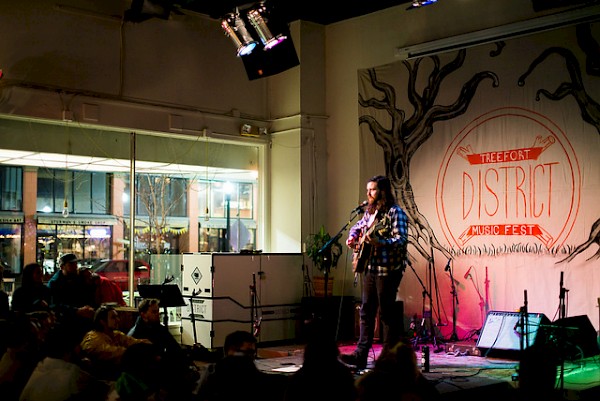 Bryan John Appleby at Boise's District Coffee House: Photo by Maggie MattinsonIn his lovely, hour-long set at the District Coffee House before perhaps 65 souls mostly strewn about the floor, Bryan John Appleby hammered at the heart space and showed off his own Treefort swag (a water bottle), offering peaceful Cat Stevens/John Denver moments.
Bryan John Appleby at Boise's District Coffee House: Photo by Maggie MattinsonIn his lovely, hour-long set at the District Coffee House before perhaps 65 souls mostly strewn about the floor, Bryan John Appleby hammered at the heart space and showed off his own Treefort swag (a water bottle), offering peaceful Cat Stevens/John Denver moments.
While managing not to take himself too seriously.
“Thus concludes the intro portion of that song,” the bearded, flannel-clad songster chuckled. “I’m really excited to get into a relationship with Boise,” the Seattle-based musician noted. “I finally learned how to say her name.”
During Sister Crayon’s high-energy set at El Korah Lounge, arguably the fest’s most iconic venue—notable for its wood-paneled, 1930s-era front hallway featuring hundreds of photos of Shriners, old (probably dead) white guys with distinctive hats—lead vocalist Terra Lopez took a break from tossing her black mane hither and thither to don a Treefort ballcap. Huge synth hooks kept 200 or 300 busting a move, and the breakbeats were funky enough to suggest shades of underground hip-hop as well as 1990s pioneers like Meat Beat Manifesto.
The group’s latest album, Devoted, and current sound was crafted in part by producer Omar Rodriguez-Lopez of The Mars Volta fame. It’s a sly mashup of dubstep and rock, looped and live beats. Think Björk, updated for 2016 and with less discernable chordal movement and a more hook-oriented, hip-hop aesthetic.
At one point, Lopez walked away from the microphone, yet continued singing. Amazingly, her voice stood out above the grooves and the crowd gave her voice the space it needed. It was a spooky, beautiful moment, a day after Naytronix’s Nate Brenner (of Tune-Yards fame) similarly threw out the playbook when he skipped through the crowd playing a two-toned African cowbell.
The power trio’s nerdy math rock and matching tribal T-shirts married ambitious progressions and chord changes with complex polyrhythms. Lyrics about “living in a magazine” and “baby, I can’t afford that California stuff” didn’t offer the same energy in the live environment as on record, but there was plenty of head nodding.
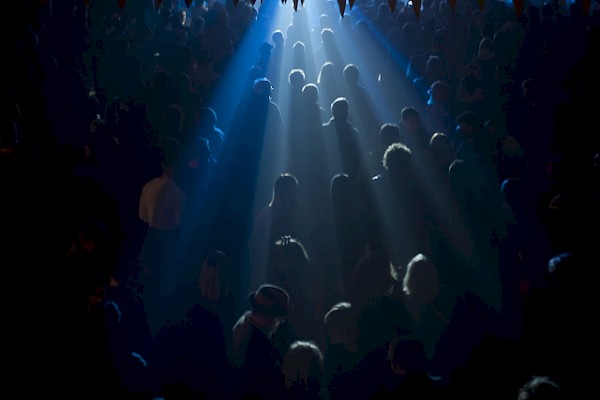 Basking at El Korah: Photo by Patrick SweeneyHow hip is Treefort? There was a rumor amongst volunteers that a staff person from a powerful, big-money foundation was hanging out, talking with organizers about replicating Treefort in a much larger market.
Basking at El Korah: Photo by Patrick SweeneyHow hip is Treefort? There was a rumor amongst volunteers that a staff person from a powerful, big-money foundation was hanging out, talking with organizers about replicating Treefort in a much larger market.
The Paul G. Allen Family Foundation is thinking about giving a “retarded amount of money” to copy the Treefort model in Seattle, one said, producing a legitimate-looking business card. Could something as intimate and grassroots as Treefort work in Seattle? Heck, maybe Bumbershoot needs a little more competition.
But while there were long lines outside multiple venues on every night of the fest, and organizers said they expect to make real money in 2016 after finally breaking even for the first time in 2015, Treefort still felt incomplete.
Despite the undeniable charm of Boise’s small downtown, many concertgoers appeared to struggle with logistics. The 21-and-over venues were spread out over about 50-odd square blocks—and road construction blocked several important sidewalks. Major arteries and highway on-ramps brought vehicles moving at high speeds just a few inches from drunk and high festival attendees.
Last year, the City of Boise awarded Treefort $25,000 and gave it “Cultural Ambassador” status. In its literature and in its earnest approach to seemingly all things, Treefort expounds its progressive values. Part of this is its B Corp certification, a designation as an ethical, albeit still profit-oriented, organization.
“We like to say that Treefort is a for-profit entity run like a nonprofit,” Treefort spokeswoman Kymm Cornelison said. The B Corporation website’s “About Treefort” section describes it as “driven by a purpose much more than the lure of profit.”
Given the American music industry’s storied history of robber baron behavior, one has to wonder if such an unabashed “trust us” mentality can exist more easily in places like Boise, Idaho.
In an interview shortly before the fest, Cornelison declined to share any information about the fest’s finances, but noted that “we’ve surpassed our goals.”
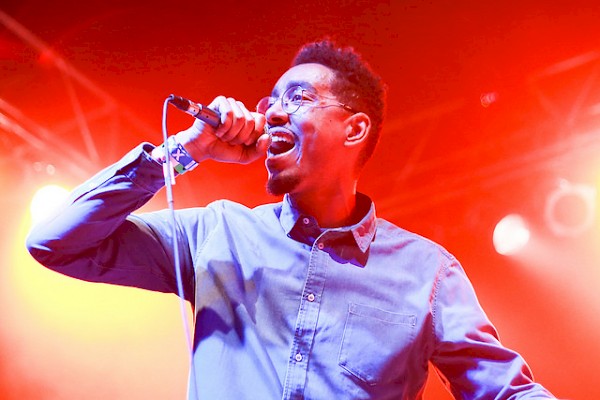 Oddisee at Boise's Knitting Factory: Photo by Kristen McPeekWashington, D.C. product Oddisee’s cloistered Knitting Factory performance left little doubt that Boise has its share of heads, whatever their ethnicity. Tall, angular and lyrically virtuosic, Oddisee’s singsong flow brought reminders of hip-hop pioneers A Tribe Called Quest just six days after Tribe rapper Phife Dawg’s too-early death.
Oddisee at Boise's Knitting Factory: Photo by Kristen McPeekWashington, D.C. product Oddisee’s cloistered Knitting Factory performance left little doubt that Boise has its share of heads, whatever their ethnicity. Tall, angular and lyrically virtuosic, Oddisee’s singsong flow brought reminders of hip-hop pioneers A Tribe Called Quest just six days after Tribe rapper Phife Dawg’s too-early death.
Oddisee, real name Amir Mohamed el Khalifa, is a drum with words that defies easy comparisons. The near-capacity crowd happily embraced his call-and-response chants, such as, “What’s that hustle?” You already know.”
“I belong to the world,” the crowd hollered along with the emcee, who looked somewhat lonely on the Knitting Factory’s sizeable stage with only a DJ behind him—rocking an all-digital rig, no vinyl in evidence. The line was anthemic, and it felt healing.
“Is it Boy-zee or Boy-see?” he asked, smiling, on his first trip to town. The audience’s cacaphonic response only confused the issue further.
While the show was, like Thee Oh Sees and Thunderpussy’s, among the best I caught, I couldn’t help but wonder how much better Oddisee could be if he were joined onstage by a hype man to ratchet the energy up, and/or a vocalist to deepen the emotional content.
Judging by the numbers of people wandering around peering into their smartphones, this reporter wasn’t the only person to create a custom show schedule based on numerous, diverse playlists Cornelison said organizers’ “friends” created. (Trail Mix, the best of the bunch, is a pay-what-you-can download of 60 mp3 files whose proceeds benefit Boise Rock School.)
“I’ve been to one not-great show,” said volunteer Amanda Copps, 22, from Boise. “I feel like the app made everything more accessible.” She was 16 shows into her daunting 35-show plan. “I took a lot of time to figure it out,” she said, then snickered. “I might skip some.”
While Cornelison and Treefort organizers have yet to release official stats and post-festival news as of publication—is it possible their hangovers may actually last until mid-April?—slack attendance was rare at the festival, a point punctuated by the Thundercat and Thunderpussy concerts. The two groups have nothing in common besides the first seven letters of their name and the fact that they both had ridiculously long lines outside their Treefort sets, which overlapped in time.
As the fest starts to feel more like a marathon and less like a sprint, you let go of checking the app, and you go where your friends go, or you follow your ears.
Seattle’s Mamiffer started their shimmering ambient experimental set with lots of crisp treble, eventually spattering their anti-pop canvas with what seemed like nearly all the colors of the sonic palette. The multi-instrumentalist knob-twiddlers brought oceans of synth waves crashing down, but still cultivated a peaceful center, perhaps a more EDM-oriented sibling to pioneering Duluth, Minn., indie band Low.
The songs were not well integrated, the show nowhere near packed, but Faith Coloccia’s vocals and the sheer creative energy of the sound more than made up for the sparse attendance.
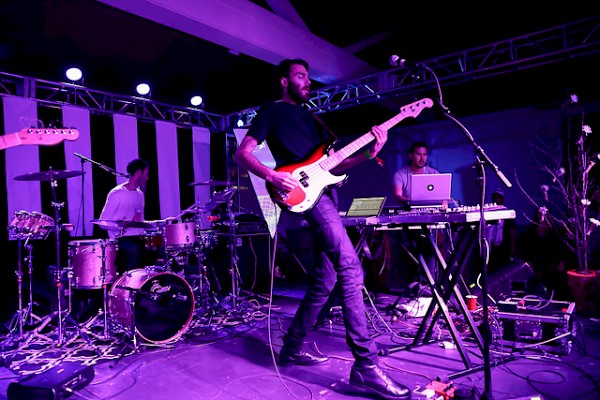 Bear Mountain at Boise's Rose Room: Photo by Elton de LeonAttendance was not a problem for Vancouver’s Bear Mountain at Rose Room, however.
Bear Mountain at Boise's Rose Room: Photo by Elton de LeonAttendance was not a problem for Vancouver’s Bear Mountain at Rose Room, however.
“Put your fucking hands in the air,” frontman Ian Bevis hollered, and people did as they danced. Bear Mountain featured thumping basslines that'd make a Chicago house DJ proud and infectious melodies, equal parts rock and EDM.
Bevis is quite tall, about 6 feet, 6 inches, and his stage presence, together with the ensemble’s heartbeat-on-cocaine energy, really holds your attention. His vocals grow on you, but don’t instantly command your respect. Yet their Treefort show suggested their sound is greater than the sum of its parts, and they appear to have plenty of momentum.
Boise artist collaborative LED’s set featured the engaging spectacle of contemporary ballet dancers leaping about, but the performance was marred by technical issues that reappeared at other shows in the Rose Room. Marrying an accordion with eight dancers and solid, bluesy numbers that brought to mind Portugal. The Man, LED was better live than on record, though the crowd was half Bear Mountain’s.
Though they weren’t on my app schedule, I was lucky to stumble upon Boise legends Built To Spill on the main stage. The group’s uber-guitar-centric set did not disappoint, suggesting the aging alt-rockers might have a thing or two to teach the many twentysomethings.
“We’ll just keep playing until someone comes out and shuts us off,” frontman and lead everythinger Doug Martsch said.
Including four electric guitars in a single band can be a poor choice, particularly in 2016 when digital wizardry is as likely to hold the fort. Yet when you have the kind of chemistry, melodies, arrangements and songwriting Built To Spill has, it all hangs together quite nicely. While, industry-wise, Built To Spill has probably “emerged” about as much as they ever will, their set showcased the kind of authenticity the Treefort brand, on the heels of a dynamic and exhausting fifth year, is coming to symbolize.

